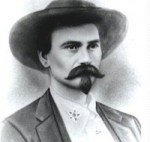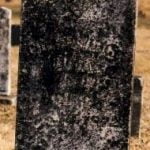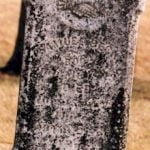
Knowing Zeke’s social standing and being held in high esteem for his work for the Indian Territory Mary’s family was up in arms as they did not trust the Cherokee Court system to try Ezekiel Proctor and convict him.
Since manslaughter was not a charge in those days and he was guilty of assault on a white man the Beck’s wanted Zeke tried in Federal Court at Ft. Smith Arkansas according to white man’s law. Mary’s family wanted to see him hang for her death. The trial was put off more than one time by each side arguing over who would be the trial judge. The trial was finally set for April 15th and the judge would be Black Hawk “Cornick” Sixkiller. Just about everyone in Indian Territory took sides in this matter and feelings were running high. The court expected trouble of some kind during the trial, so it was decided to move it out of the Goingsnake District Court House to the Whitmire School. The thought was that with fewer doors and windows it would be easier to defend in case of trouble.

1st husband of Julia Ann Hildebrand Beck Bee and son of Joseph Beck brother of Mary
The head of the family, Aaron Beck, who at one time had been good friends with Zeke, warned his family, armed or unarmed, to stay away from the trial and let the authorities handle it.

Son of Ellis Beck, brother of Mary Beck Hildebrand Kesterson
Some members of the Beck family convinced James Kesterson to go to Fort Smith Arkansas and seek a writ for the arrest of Proctor for assault with the intent to kill. He did this on April 11th. After James filed the writ he disappeared and no one knows what happened to him. The court sent two deputy marshals with the writ for arrest to the trial. They were only to arrest Zeke if he was found not guilty.
Several Beck family members had accompanied Kesterson to Ft. Smith and they returned with the Deputy Marshals to Indian Territory and thus to the Whitmire School and arrived just after the trial had began.
The Judge sat at a small table at the rear of the one room schoolhouse facing the door to the west. Joe Starr, the court clerk, sat to the Judge’s left and Mose Albberty, Proctor’s attorney, sat to the right of the Judge. Proctor was sitting next to his attorney and one of his guards stood near him. The jury sat to one side of the room.
The one room schoolhouse was packed with spectators and many that could not get in were milling around the building on the outside.

Husband of Sabra Ann Beck and daughter of Jeffrey Beck Jr. brother of Mary Beck Hildebrand Kesterson. Killed at the mill.
Just as the trial began the Deputy Marshals and the Beck posse arrived. There were 4 guards outside of the building to keep out unwanted intruders. Deputy Owens told the posse not to try and enter the courtroom and remain peaceably outside until the court’s decision was made. Surry Eaton Beck seemed to take command of the posse as they neared the building. There were other family members and friends who were waiting and the two groups merged as they went to the door of the school.
Surry or “White Sut” Beck had a double-barreled shotgun and he forced his way inside and others followed and the guards were over powered. They burst into the courtroom, guns in hand. “Sut” aimed his shotgun at Zeke. Johnson Proctor, Zeke’s older brother, grabbed the gun barrel and one of the barrels went off and he received the full charge in the chest and immediately died. The other barrel then went off wounding Zeke in the lower leg below the knee. Zeke grabbed a guard’s gun and began to fire it.
Surry Eaton White Sut Beck who led the assault was severely wounded but managed to escaped on horse back. Deputy Marshall Donnelly stated that Deputy Marshall J. G. Peavy helped Beck escape to Cincinnati, Arkansas. He had a close encounter there with Proctors friends, who were looking for him, but he narrowly escaped them.
Then pandemonium broke out as the Beck and Proctor factions fired wildly. The fight lasted about 15 minutes and the wounded, dead and near dead lay everywhere inside and outside of the school. Most of the Beck faction fled and so did just about everyone who could get on a horse and ride.
Nine were killed outright and two died the next day. An unknown number had minor wounds. William Beck and Deputy Owens were mortally wounded and were carried across the street to a private home where they died a short time later. Owens stated before he died that he tried to stop the battle but could not. The lady who owned the house across the street got her sons to hitch up the mules to the wagon and with the help of others loaded the wagon with the dead. They laid them out on their front porch till family members could come and claim the bodies.
The wounded were taken inside and treated, the best she could by Mrs. Whitmire who was a widow.
The dead were:
- Johnson Proctor (Died immediately, older brother of Ezekiel)
- Samuel Beck
- Jesse “Black Sut” Beck (my great grandmother’s first husband. She was left with a son about a year old. Her mother had died in February at the mill and now her husband was gone too.)
- Defense Attorney, Mose Alberty
- Andy Palone
- William Hicks
- Jim Ward
- George Selvidge (married to Sabra Beck)
- Riley Woods
- Deputy Marshall Owens (severely wounded and died the next day).
The court reconvened the next day and Zeke was acquitted of all charges.
He knew that the Beck’s would be hunting him down, so he disappeared with his close friends and hid out for several months.
Here is an eye witness account from a reporter who arrived late and just after the shooting was over. This appeared in the Cherokee Advocate newspaper on 20 April 1872. The reporter got to the trial right after all the shooting had stopped. He describes the carnage that was left after it was over.
